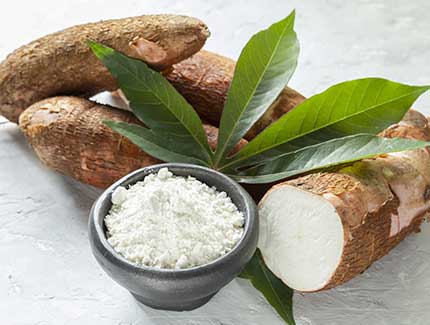Thailand: Cassava Starch Production

Cassava starch processing
Cassava starch production in Thailand involves using 4 kilograms of fresh cassava roots to yield 1 kilogram of starch with 25% starch content. Advanced large-scale facilities are replacing older, smaller factories. Two processing methods exist: traditional and modern.
The traditional process, primarily used in small-scale factories, entails nine steps, including weighing, peeling, grinding, and drying, resulting in lower-quality starch.
The modern process, employed by larger factories, involves eight steps and modern equipment like Rasper, Decanter, and Centrifuge, producing high-quality starch quickly. Both processes contribute to cassava starch production, with modern methods offering efficiency and superior quality.
Cassava starch has versatile applications:
including direct consumption as sago pearls, noodles, and desserts. It serves as a substrate in various industries, such as amino acid, sweetener, and bio-ethanol production, along with organic acids. Monosodium glutamate and L-lysine, derived from cassava starch, find use in the food and feed industry. Additionally, cassava starch acts as a biofuel raw material. It can also be modified for diverse industrial purposes. Cassava pulp, a by-product, is valuable for animal feed, composting, mushroom cultivation, and biogas production. Both cassava starch and pulp are vital substrates across multiple industries.
Cassava starch production and consumption in Thailand face several challenges:
Numerous challenges affect cassava production and consumption in Thailand. These challenges include a decrease in cassava root production due to diseases and urbanization, rising costs, and competition from other agricultural products. In the processing sector, issues revolve around cassava root quality, machine efficiency, and high equipment costs. Labor shortages and related expenses are also significant concerns. Resource availability, regulations, and an increasing number of cassava starch factories impact production costs. Water quality and escalating electricity prices add to operational expenses, while compliance with EU and USA regulations on contaminants raises costs as well.
Government policies present opportunities and barriers in the cassava industry:
Opportunities for cassava products include addressing supply chain shortages (e.g., corn and wheat), tapping into global markets, supporting root supply and farmers, and serving as an ingredient for those with Celiac disease. Government price intervention is also beneficial. Barriers to cassava products include potential tax issues, regulatory alignment for export products, and intense competition within the tapioca industry, covering cassava starch, chips, and bio-ethanol production.
Innovation/Modern technology
In Thailand, innovation in cassava starch production involves clean label technology, improved machine efficiency (extractor, separator, and centrifugation for water conservation), and the use of Supervisory Control and Data Acquisition (SCADA) systems for process control. Innovations in tapioca products include waxy tapioca starch, catering to clean label trends and product stability. High-quality cassava flour development targets gluten-free applications. Furthermore, by-products like cassava pulp and anaerobic digestion sludge are utilized as soil fertilizer to enhance cassava root production quality, fostering sustainable practices in the industry.
SWOT Analysis
Strengths:
- Prominence in the global starch market.
- Largest cassava plantation area regionally.
- Internal biogas and electricity generation.
- Extensive experience in cassava cultivation.
- Close proximity to the sizable Chinese market.
Weaknesses:
- Aging facilities and factories.
- Lengthy lead times for machine parts.
- Dependence on manual labor, resulting in high labor costs.
- Elevated logistic and transportation expenses compared to neighboring Southeast Asian nations.
- Limited diversity in High-Value Added (HVA) products.
Opportunities:
- Government backing for the bioindustry sector.
- Growing consumer trends in health and food safety.
- Global instability, like the Russia-Ukraine situation.
- Shortfalls in corn and wheat supply.
- Access to novel cassava production technologies and knowledge.
- Post-COVID-19 expansion of online markets.
- Enhanced reliability of tapioca products.
Threats:
- Stringent regulations imposed by the European Union (EU).
- Cassava Mosaic Virus (CMV) impacting cassava crops.
- Chinese government support for domestic tapioca starch production.
- Fierce competition in planting areas.
- Escalating cassava production capacities in CLMV (Cambodia, Laos, Myanmar, Vietnam).
- Insufficient labor interest in the cassava industry.
